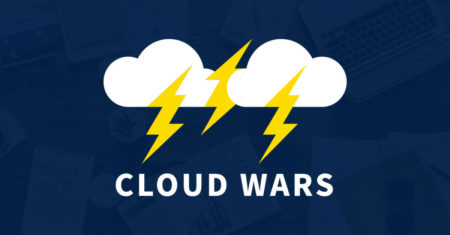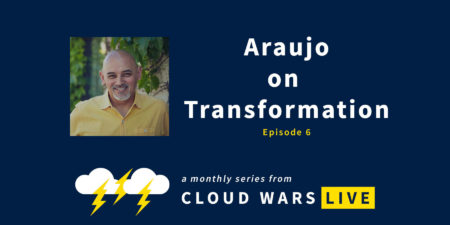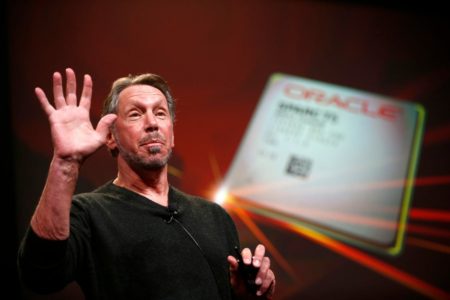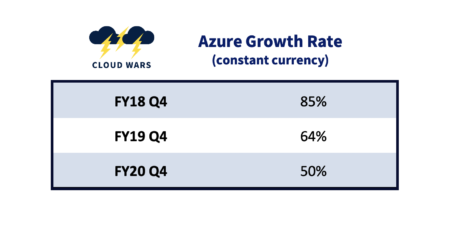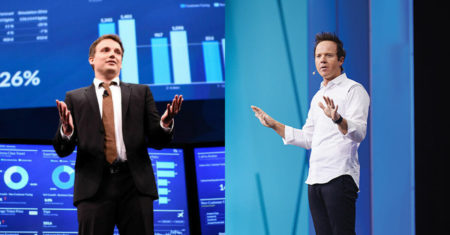Following its release of quarterly results, cloud leader Salesforce’s shares shot up by 25%, giving it a market cap of almost $250 billion.
On the Cloud Wars Live podcast, Bonnie Tinder talks negotiations with the C-Suite (and especially the CFO) on digital transformation and more.
In its Q2 earnings presentation, Salesforce included a CRM revenue market-share chart from IDC showing its increased dominance in 2019.
Market-cap valuations can be fleeting, but they provide an objective view of how the global market values companies like SAP, Salesforce and Oracle.
On the Cloud Wars Live podcast, Charles Araujo explains how business leaders can and should be preparing to “manage” robots in the workforce.
As Salesforce becomes the first SaaS company in history to reach $5 billion in quarterly revenue (for Q2), a preview of its 8/25/20 earnings call.
On the Cloud Wars Live podcast, Tony Uphoff and I talk how business may change when everyone knows how to code. That’s data culture.
An overview of what we know and don’t know about the high-level details of Microsoft Azure revenue and Microsoft cloud revenue in general.
Microsoft has put together an extraordinary list of partnerships with most of the world’s leading retailers by helping them elevate customer experiences.
Stream the Cloud Wars Live podcast to hear Wayne Sadin’s suggestions for CXOs on excellent and inexpensive gear to optimize effectiveness of video meetings.
A few thoughts on why Microsoft, Amazon, Salesforce, and Google top the Cloud Wars list of the world’s largest and most-influential cloud providers.
Larry Ellison has reassigned former cloud infrastructure chief Don Johnson, as part of a shuffling of Oracle execs to reimagine its cloud capabilities.
A few reasons why I believe that Satya Nadella and the Microsoft executive team are extremely pleased with continued hyper growth from Azure.
A look at how Salesforce measures up against Microsoft, SAP and Oracle when it comes to hitting the $5 billion in a quarter mark.
On the Cloud Wars Live podcast, SAS EVP, COO and CTO Oliver Schabenberger joins me to discuss his company’s powerful partnership with Microsoft.
In contrast with Salesforce, ServiceNow and IBM, Larry Ellison and Oracle have all but banished “platform” from their public presentations.
In this time of rampant disruption, change, and digital-everything, Bill McDermott and ServiceNow are promising to give businesses the gift of speed.
On the recent Amazon earnings numbers, to clarify: anyone who thinks that AWS is “in trouble” or because its growth rate was “only” 29% is nuts.
With a 43% revenue-growth rate that was much higher than those of its larger rivals, Google Cloud continued to be the fastest-growing major cloud vendor.
“For Microsoft, COVID-19 was personal on many levels.” – Microsoft Chief Medical Officer Dr. David Rhew, who’s helping to drive innovation amid crisis
Ashley Goldsmith is leading efforts at Workday to ensure employee safety and happiness during and after COVID-19, while strategizing a return to work.
On the Cloud Wars Live podcast, Sean Ammrati talks about what Slack’s lawsuit against Microsoft means for the future of cloud (and much more).
While I applaud the CEO’s unblinking confidence, I have questions about why SAP is spinning out Qualtrics, a company said to be SAP’s crown jewel.
40-year-old Christian Klein gave a confident performance on the SAP Q2 earnings call of which a CEO of any age would be proud.
On the Cloud Wars Live podcast, Tony Uphoff and I talk workspace trends, from hiring upticks to open office plans to the new remote work reality.
As Microsoft cloud revenue soared to $51B on the strength of $14.3B in fiscal Q4, Azure led the way as usual with 50% hypergrowth. But there’s more!
From January when his appointment was announced until April 6 when became CEO, Arvind Krishna did 5 things very well in his debut quarter.
AI Copilot Podcast

AI Agent & Copilot Podcast: Kyndryl AI Readiness Report Finds People, Orgs Have a Steep Hill to Climb
Most companies aren’t ready for AI — not culturally, technically, or in terms of workforce adoption — despite the rapid pace of technological advancement.






